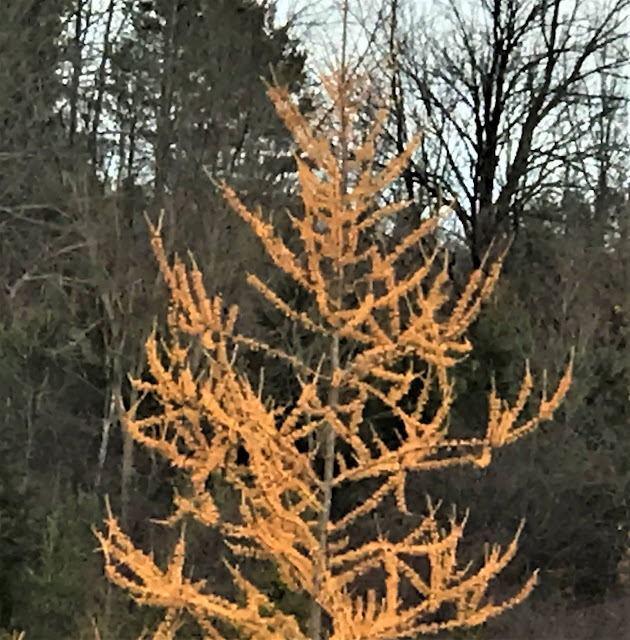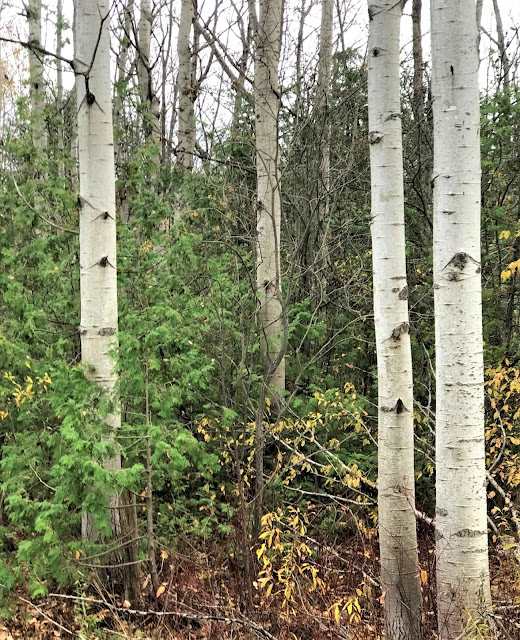Driving home from physio the other day, we noticed these beautiful Tamaracks in a field at the corner south of Woodbridge. The leaves have now fallen from most trees, but these Tamarack are the only conifers here whose needles turn a golden orange and drop off. So they're not evergreens, but they are conifers; they're deciduous conifers. In any case, about 3 weeks after the glorious colour of the hardwoods here, the Tamarack add a beautiful exclamation mark to the end of fall.
In fact, most of these may not be Tamarack at all, but European Larch. Widely planted because they grow faster, European Larch are virtually indistinguishable from Tamarack. But I feel a loyalty to our native trees, so I just call them all Tamarack.I just wish I could get out there myself and see all the little tiny needles growing in tiny clumps of the twigs, as well as the tiny cones.
Driving down the road we slowed through a wet forest with lots of Poplar (probably Trembling Aspen). Mrs. F.G. always enjoys the patterns on the bark.
The older bark near the base of the larger trees gets quite rough and corrugated, making it look like a totally different tree.
****
Cold and wet here today. The nice fall temperatures have dropped and it was just above freezing this morning. Snow in the forecast for tomorrow.








Thanks for the beautiful photos!
ReplyDeleteLove the tamarack, called juniper here. Ours are turned now too. Our weather sounds like yours, on a day delay, FG.
ReplyDeleteAt first glance I thought the Tamaracks were dead pines. Nice to know they're very much alive.
ReplyDeleteIt's very wet here with yet more rain in the forecast and wind. Not pleasant at all. Snow is much prettier.
Our tamarack have dropped their needles. A few babies protected by the white pines are still yellow though.
ReplyDeleteI love the bark of the poplar trees too. One of my favorites looks like someone went at it with an axe years back. It still flourishes.
We just looked at the Live Cam from the Algonquin Lookout. The snow is starting to fall there so I expect it will draw closer to us tonight.
Interesting looking. Like GM I thought they were dead at first too.
ReplyDeleteI'm not certain I've seen tamarack before but I know they are native to Saskatchewan. My guess would be I haven't been paying attention.
ReplyDeleteStay warm! It's definitely winter here.
The Nature Museum has a couple of them on the grounds, but when I stopped by they hadn't turned.
ReplyDeleteI love seeing the tamarack. I thought larch was just another name for them. I learn something every day.
ReplyDeleteI call them all Tamarack also and their gold on a sunny day is stunning!
ReplyDeleteI think we have a few Tamaracks in our area but I don't think we have groves or groups of them like you have up there further north. I'll have to keep an eye out for Tamaracks now that you mentioned them.
ReplyDeleteIt is a beautiful color on the leaves of the trees. I like your trunk study.
ReplyDeleteHere's the way I distinguish Larch from Tamarack. Look at the cones - T for tiny, T for Tamarack; L for large L for Larch.
ReplyDeleteI have learned something new -- that tamarack and larch are not the same tree. I had thought it was two names (one British) for the same tree.
ReplyDeleteWe only have a few tamarack in widely scattered bogs and fens remaining from the last glaciation, most of the larch here is either European or, more commonly, Japanese. Leopold's essay on their fall color introduced me to his writings over 60 years ago.
ReplyDeleteThe larch is a very pretty tree at this time of year. X
ReplyDeleteThose Tamaracks look so lovely!
ReplyDeleteInteresting. I have seen some at the State Arboretum.
ReplyDeleteLike plants, I'm not good at recognizing these lovely trees either. Great photos, the bar is always interesting on poplars and birch.
ReplyDeleteSorry about the snow, we trust you'll enjoy it for us. ♥
a first for me, they are beautiful!!
ReplyDelete